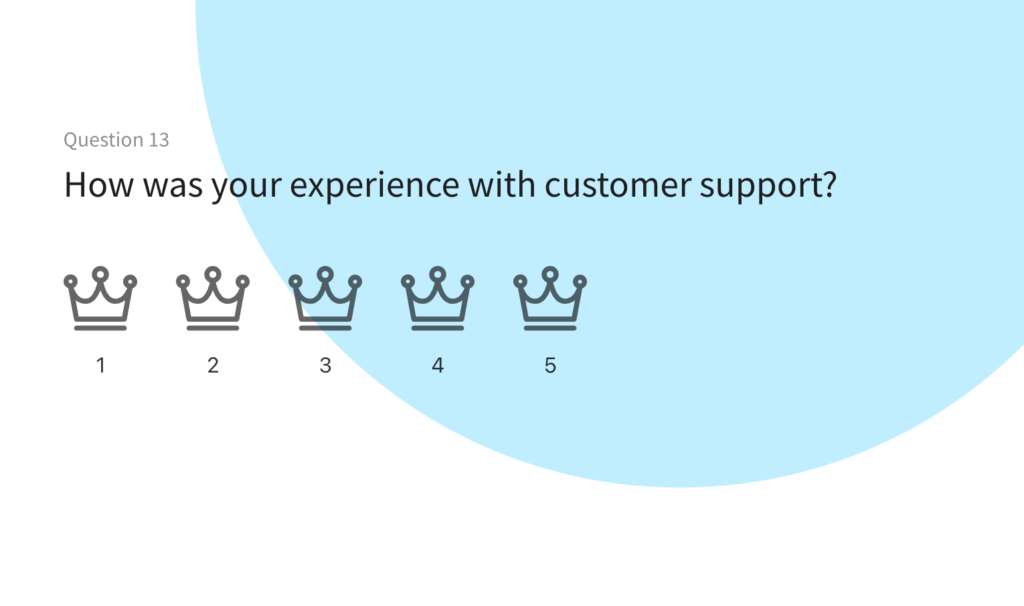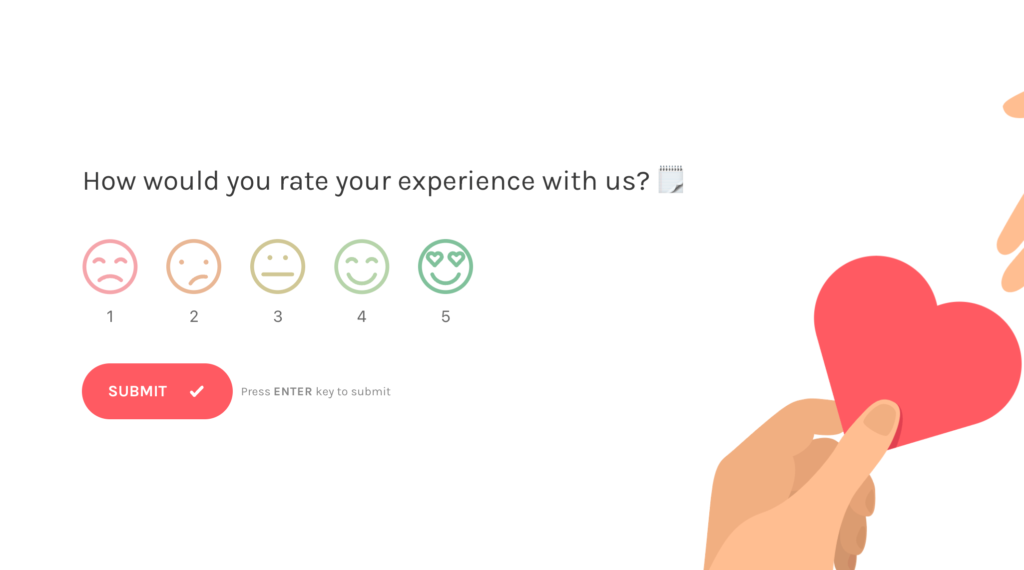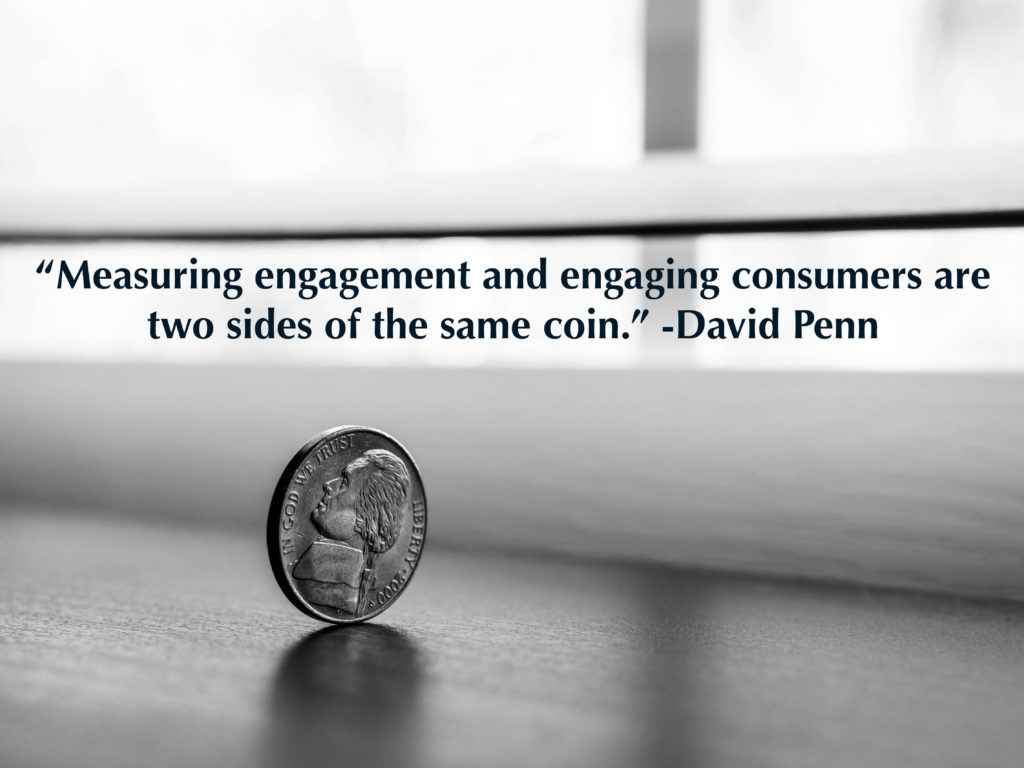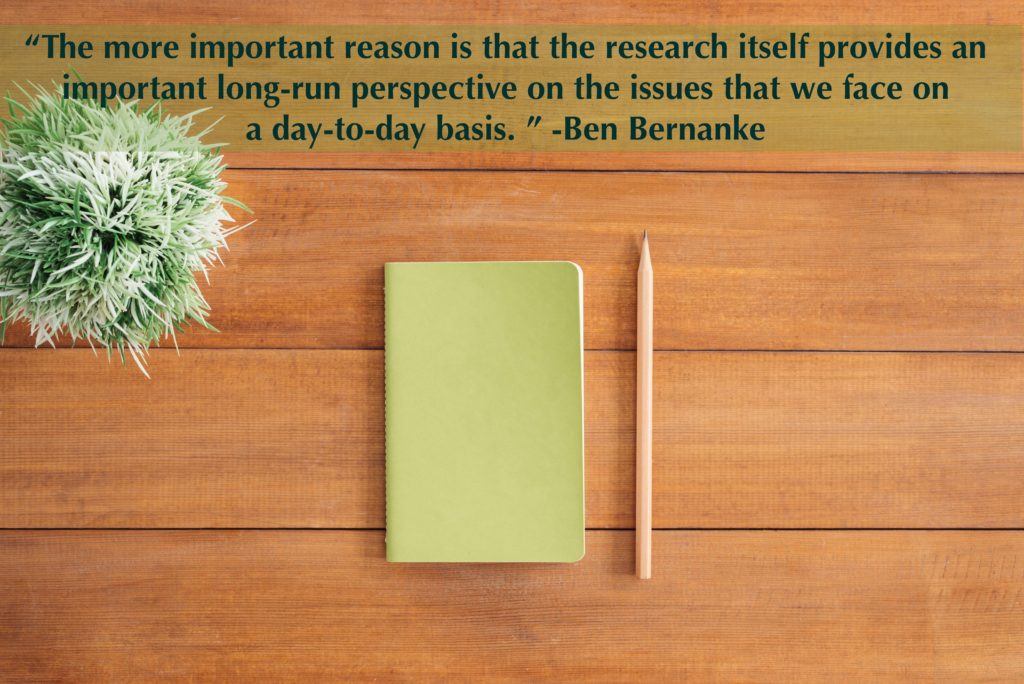Survey & Feedback
Likert Scale: Ultimate Guide to Likert Scale Surveys
Article written by Kate Williams
Content Marketer at SurveySparrow
21 min read
19 September 2025

60 Seconds Summary:
Whether you're crafting your first survey or refining an existing seasoned feedback form, understanding the Likert scale is essential. It’s one of the most widely used tools in survey design and it's great for for measuring attitudes, opinions, and satisfaction with clarity and consistency.
In this comprehensive guide, we cover what it is, why it matters, and how to use it effectively.
You'll read about the following so jump to your relevant section:
- What is a Likert Scale? – A simple explanation with examples
- Likert scale types – 3-point, 5-point, 7-point, and beyond
- Different Types of Likert Scale Survey Questions (& when to use them)
- Reasons to Use Likert Scale Surveys
- Why to use it – Best use cases and benefits
- Step-by-Step Guide
Have a heart-to-heart conversation with your loved ones if you want to understand about their deep thoughts. But if you want to know what your customers think about you deep down, then use a Likert Scale Survey.
Why? Because when it comes to finding customer’s opinions about a brand, the Likert Scale Survey is one of the best choices.
What is a Likert Scale?
To understand the Likert scale definition, we first have to learn what a survey scale is.
A survey scale is simply a way to organize different possible answers, whether they’re words or even images, so people can easily share how they feel about something. Think of it as a tool that helps you get a clear picture of what your customers or users really think about your product or service. By offering a range of choices, you make it easier for people to express their true opinions-whether they love what you’re offering, think it could use some work, or feel somewhere in between
The Likert questionnaire is usually a 5 or 7-point scale which is designed to measure attitudes and opinions by asking your customers a series of questions on a specific topic. Named after its creator Rensis Likert in 1932, it’s one of the most reliable ways to measure opinions, attitudes, and behaviors toward your brand, business, product, or service.
What makes the Likert scale so valuable? It provides a much clearer picture than simple Yes/No responses by offering different degrees of opinion that help you understand feedback with remarkable clarity.
Imagine asking a customer, “Did you like our service?” A simple “yes” tells you very little about their actual experience. Were they blown away or merely satisfied? The Likert scale eliminates this ambiguity by capturing the intensity of their response.
Most people get confused between matrix questions and Likert scales. The fact is that the Likert scale is a certain type of matrix question, while a matrix question is a format for the Likert question. The Likert scale is meant to measure people’s opinions linearly, while matrix questions are presented in a matrix or grid.


Types of Likert Scales
Now that we have understood the benefits of the Likert scale, let’s discuss the two main types of Likert scale surveys. Understanding each will give you a better idea of which to choose and when. Doing so can help you accurately capture the nuances of the respondent’s feelings and thoughts.
1. Odd Likert Scales
Like the name says, this type of Likert scale deals with an odd number of scale points for respondents to answer. It includes a middle ground or neutral option, allowing the respondents to neither agree nor disagree with your given statements. This type of scale is great to capture the neutrality of the respondents’ opinions.
5-Point Likert Scale: The most used, this scale ranges from “Strongly Disagree” to “Strongly Agree,” with a neutral option like “Neither Agree nor Disagree” in the middle. It can be used to measure satisfaction, agreement, frequency, and likelihood, among others.
7-Point Likert Scale: This scale adds a bit more granularity by including additional levels of agreement or satisfaction on either side of the neutral option. It’s generally used for topics requiring more nuanced responses.
9-Point Likert Scale: Less common, the 9-point scale offers even more detailed options, allowing for a very fine analysis of attitudes or opinions. However, its complexity can come across as overwhelming for respondents.
2. Even Likert Scales
Even Likert scales do not include a neutral option at all, forcing respondents to make a decision even if they are slightly indifferent. This is useful for getting a clear stance on issues where neutrality is less informative.
4-Point Likert Scale: Without a neutral middle option, respondents must choose a side, which can be particularly useful in situations where a decision or a clear preference is necessary.
6-Point Likert Scale: Adding another layer to the 4-point scale, the 6-point scale forces a more nuanced choice by providing three levels of agreement or disagreement but still no neutral option.
Selecting the right type of Likert scale depends on the research objectives and the kind of data needed:
For General Inquiry: A 5-point scale is often sufficient for general surveys where a broad understanding of attitudes or opinions is needed.
For Detailed Analysis: When a more detailed analysis of responses is required, a 7-point or even a 9-point scale can provide deeper insights.
For Decision-making: In scenarios where it’s crucial to push respondents towards a decision, an even-numbered scale like the 4-point or 6-point can be more appropriate.

Explore Deeper Customer Insights with SurveySparrow
A personalized walkthrough by our experts. No strings attached!
Different Types Of Likert Scale Survey Questions You Can Use
A perfect way to ask for people’s opinions is to tell them to respond to a Likert survey. In fact, there are four different styles of Likert scale survey questions available to measure your respondents’ opinions. These are-

1. Agreement
These types of Likert scale questions are the most popular, as you can use them for any purpose. You can simply learn how much people agree or disagree with your products or services. On a traditional five-point Likert scale, you can include the following responses.
- Strongly agree
- Agree
- Neither Agree Nor Disagree
- Disagree
- Strongly Disagree
2. Likelihood (or Frequency)
This type of Likert scale question is meant to determine your customers’ behavior. Whether they’d like to continue their purchasing journey in the future or recommend your organization to others, you can get all the answers using likelihood Likert scale questions.
For instance, let’s assume you run an online clothing store. And you want to know whether online customers recommend your brand to their friends or family. You can create a Likert scale with a question like-
Example: Based on your recent online shopping experience, how likely or unlikely are you to recommend our clothing brand to your close ones?
The likely and unlikely parts becomes your statements. And these are the different options.
- Very likely
- Likely
- Unlikely
- Very unlikely
Likelihood Likert questions don’t necessarily need a mid-point neutral option. That means you can skip neutral options and opt for an even number with the responses.
3. Satisfaction (or Interest)
Do you know how satisfied your customers are with your business services or products? Do you measure your employee satisfaction regularly?
If your response is negative, do stress on the below statistics:
- Organizations with highly engaged employees experience a 25-59% decrease in turnover.
- 58% of consumers agreed that they’ll switch companies based on their poor customer service.
- 93% of customers will do repeat business with a company that provides great customer service.
- 58% of employees wished their organization conducted employee engagement surveys more frequently.
You’ve probably guessed by now that keeping your customers and employees satisfied will result in high profits and low turnover rates.
But, how can you measure their satisfaction with an experience they had with your brand? If you want a subjective opinion from people about your brand, products, or services, satisfaction Likert scale questions are the best option.
Here’s an example of satisfaction Likert scale questions for your next survey:
Example: Based on your recent interaction with our customer support team, how satisfied or dissatisfied are you?
The satisfied and dissatisfied parts can form two statements, just like in the previous examples. And your customers can choose from these options.
- Extremely satisfied
- Not satisfied
- Somewhat satisfied
- Dissatisfied
- Extremely dissatisfied
4. Importance
With importance Likert scale question types, you can gauge how strongly customers feel about a certain product or product’s features. This type of scale can help you understand customers’ expectations and requirements.
Let’s say you’ve launched a new survey software in the market. Now, you want to know what people think about the features of your newly launched software. So, you can ask them an important Likert question like this:

Example Prompt:
We hope you had a great experience with our survey software! Please rate how important the following features are to you.
| Software Features | Extremely important | Neutral | Low importance | Not at all important |
|---|---|---|---|---|
| The user-friendliness | ||||
| The UI | ||||
| The design | ||||
| Data security | ||||
| Software pricing |
Here’s something to help you determine the Likert scale questions you should ask and when.
7 Reasons Why You Should Use Likert Scale Surveys
We give you not one but 7 reasons why the Likert scale survey is indeed one of the best techniques to gather feedback from your customers.
Reason #1: Best for a one-topic focused survey
Likert scale surveys are best when you use them to ask a series of questions that revolve around one topic. Because when you ask questions that are relevant to a particular topic, it becomes easy to report the data when you want to analyze results from a few questions.
Let’s say you are planning to launch a new product. A mobile app for fitness tracking, maybe?
Before finalizing the features and design, you want to gather feedback from potential users about their preferences and priorities.
To do this, you can create a survey asking participants to rate various aspects of the app, such as user interface, tracking accuracy, available features, and pricing options. But again, it is necessary to use conversational forms. Why? Because old, boring long surveys usually end up being abandoned.
No need to fret! This is where pre-designed survey templates that are tailored to your needs come into the picture. You can perhaps try using SurveySparrow’s library. There is not one but over 1000 customizable templates to streamline your survey creation process.
If you are in a hurry, feel free to use this sample template and make it your own. If you are in the mood to explore, jump right ahead and build your first survey from scratch.
Likert Scale Questionnaire Template
Use This TemplateUltimately, you can collate the data to see how satisfied or dissatisfied the customers are with the process.
You can create a free account to try more awesome features, like NPS surveys and customer journey mapping. Oh, and did we mention executive dashboards? Give it a try if you like it!
Now why don’t we move on to the next reason.
Reason #2: Useful in any situation
Likert scale surveys can be used in any situation when you want to get insights from your consumers about their feeling towards your product. You can use it when you want to see if customers are in agreement with your service. This is one of the most common instances for which a Likert scale survey is used.
The Likert type is scale also widely used when you want to see if your customers would recommend your product to someone else.
“Please rate your level of satisfaction with our service” is another statement type where Likert scale makes the most sense to use. The satisfaction-based question is used when you want to get an opinion from your customers about your service.
You can also ask questions on the importance of the product. This will help unearth what your customers think about a particular product or a feature.
Reason #3: Can be used to measure the intensity
The Likert scale survey is extremely useful when you want to measure the intensity of opinion.
For example, when you ask a customer if they liked the product, the answer will be usually binary: a yes or a no.
However, when you ask the customer how much they like a product or did not like it at all, or liked somewhat, then there is a varying set of options that are available. It also becomes easy to gauge ‘how much’ your customer liked or disliked the product.

Reason #4: Can be used to gauge sentiment
Likert scale surveys are unbelievably effective when you want to get an overall sentiment measurement of a particular topic, experience, or opinion.
Likert type scales can also be used to collect data on factors that contribute to that particular sentiment.
However, Likert scale surveys should not be used to get measurements of disparate subjects or mix different sets of scales as it will create confusion.
Reason #5: Bipolar scale
A Likert scale is bipolar because it captures both extremes of an attitude.
When you use it as an odd-point scale, you can also use it to allow neutral responses.
While the 5-point scale is more common, Likert scales can have more options based on the needs. A 3-point scale would eliminate the need to identify the degree to which respondents are satisfied or unsatisfied.
Reason #6: Easy to understand
More often than not, your respondents would have taken a Likert scale survey at some point in time. Thus, it is easier for them to fill their response.
Moreover, the responses are easier to quantify and can be calculated using mathematical analysis.
Reason #7: Does not force an answer
Since it does not ask for a Yes/No answer from the respondent, it does not force the participant to give a particular answer on a topic that they might not be comfortable dealing with in the first place.
Additionally, a Likert scale questionnaire allows them to respond to a degree of agreement thus making it easier for the respondent.
Bonus: Likert surveys are also quick, efficient and are an inexpensive method of data collection.

Example of a Likert scale survey
How satisfied are you with the services at our salon?
- Very satisfied
- Somewhat satisfied
- Neither satisfied nor dissatisfied
- Somewhat dissatisfied
- Very dissatisfied
The user can choose to be neutral by replying with a ‘neither satisfied nor dissatisfied’. And if they are just satisfied, they can reply with a ‘somewhat satisfied’. To show that they are extremely satisfied, they can choose ‘very satisfied’.
The same goes for negative experiences too. This level of clarity is rarely given by other survey methods.
There are 50+of Likert scale survey questions that you can explore here.
When to employ a Likert scale survey?
There are different types of survey questions like multiple choice questions, open-ended questions, demographic questions, matrix questions and more. When do you choose a Likert scale survey? Likert scale surveys are used when you need to understand what your customers think about you deep down.
Here is when you can use Likert scale surveys:
- When you want to know what people think about your new product
- When you want to understand the experience of your customers on using your product
- To know about the customer service team’s service
- When you want to know what customers think about their order delivery
- When you want to ask webinar attendees what they liked about it
These are some of the places in which you can use the Likert scale survey. Anytime you want to measure the feelings of your customers towards your brand, Likert scale surveys are the best method to use.
The best thing about Likert scale surveys is that it is easy for the respondents to respond because it does not make the question extremely broad. Neither does it make difficult for the respondent to choose a response.

Advantages of Likert scale surveys
- One of the biggest advantages of Likert scale surveys is that the interpretation of data becomes extremely easy when you use this type of survey
- It is not binary like a ‘Yes’ or ‘No’ type question and it gives a bunch of ranges like numbers from 1 to 5 or a range from ‘low’ to ‘high’ or ‘very satisfied’ to ‘dissatisfied’.
- The respondent might want to say that their experience was extremely negative, but if the only option present was ‘negative’ then you would not be able to understand the level of their experience. The Likert scale gives the option to choose ‘extremely negative’.
- For businesses, the surveys are easy to collect and total scores can be easily calculated.
- Since Likert scale surveys use a scale, the respondents are not forced to give binary responses and can be neutral if they want to.
- Likert scale surveys are easy to create and can be run on all modes of communication making it easy to distribute
Creating the Perfect Likert Scale Survey: A Step-by-Step Guide
You obviously are looking for results from your questionnaires, which is why you are pondering how to create a Likert scale survey. If you are looking to get accurate results, then you need to be extremely precise with regards to wording your questions and the subsequent choices that you offer. Here are our tips on creating the perfect Likert scale survey:
1. Determine what you want to measure
When it comes to the Likert scale, you can’t use it to measure a lot of factors, it works best when you want to know about one thing. For example, you might want to know what your customers think about one feature that you recently introduced.
2. Draft statements
As we have mentioned, the Likert scale is extremely useful when you want to learn one thing for which you need to ask specific questions for what you are trying to measure.
Let’s say you are trying to measure customer satisfaction for a restaurant, Likert scales are best when it comes to it because there are a lot of indicators that you can write down to influence customer satisfaction. Here are some of them: delivery time, information sharing as soon as you make the order, pricing, expectations, perceived quality, the taste of food and so on.
The kind of questions that you need to ask here would be about the experience of the customer with the restaurant. Here are some of the questions that you can ask:
- I like the buying experience that I had with the restaurant (Strongly Agree-Strongly Disagree)
- The variety of options available for a consumer at the restaurant is good (Strongly Agree-Strongly Disagree)
- I liked the taste of the food that I consumed from the restaurant (Strongly Agree-Strongly Disagree)
- The time taken for the food to get delivered to my place was reasonable (Strongly Agree-Strongly Disagree)
3. Add a mix of positive and negative indicators
When you are using a positive statement like “I like the buying experience that I had with the food chain”, make sure you use a statement that describes the same in the negative too.
The negative expression for the above statement would be -“The buying experience at the food chain was terrible” The respondents who agree with the positive statements should disagree with the negative statements and vice versa.
When you get such clear-cut answers, it means that the responses are reliable.

4. Decide on the appropriate response scale
Likert Scale surveys use two types of response scales: semantic scale and number scale. When it comes to using a semantic scale, you might want to choose easy and plain options that is easy to understand in a single glance.
The most commonly used indicators in the semantic scale are: Helpful-Not Helpful, Excellent-Poor, Satisfied-Not Satisfied, Agree-Disagree, Always-Never and so on. However, you need to make sure that you use it at the appropriate place.
Let’s say if the question is “How happy are you with the service”, the accompanying semantic should be Very happy- Not happy and not Very Excellent- Not Excellent. Make sure that the scales you use are not ambitious, try to be as clear as possible.
The other type of response choice is using numbers. Likert usually has an odd number so that they can also input neutral opinions. The most commonly used numbers in Likert scale are 5-point Likert scale and 7-point Likert scale. Anything more than a 7-point scale would be unnecessary.
5. Stay consistent
Make sure that you stay true to the scale you have used in the survey.
If you have used a 5-pointer in the Likert scale survey, then ensure that you use the same scale everywhere. When you don’t use consistent scales, you can’t even be sure if you are measuring the same metric with each statement.
6. Keep testing
If you want to create a highly successful Likert Scale survey, then you need to ensure that you test the surveys over and over.
You might want to play with different scales as well as use a different set of words. Find out which ones have the most effective and keep revising and analyzing them.
Use a small pool of respondents and ask them to take the survey and see if they find any anomaly in terms of understanding or in the usage of Likert scale for the survey.

Using SurveySparrow for your Likert Scale Surveys
Creating a Likert scale survey with SurveySparrow is pretty straightforward.
First, think about what you want to measure—whether it's customer satisfaction, product feedback, or user experience. Once you've got that figured out, log in or sign up for SurveySparrow and give your project a name.
Next, list down the key statements you'd like people to respond to. When you're ready to build the scale, pick a set of clear, balanced response options—something like “Strongly Agree” to “Strongly Disagree” or “Very Satisfied” to “Very Dissatisfied.” A five- or seven-point scale usually works best: it’s simple but still gives people room to express how they really feel.
Before sending it out, test your survey to make sure everything is clear and makes sense. SurveySparrow helps a lot here—with features like conversational surveys (which feel more natural and get better responses), smart conditional logic to avoid overwhelming your audience, real-time analytics, and solid security.
In short, it’s a smooth, user-friendly way to gather meaningful insights without the usual survey headaches.
Wrapping Up
We can safely say that Likert scales have a lot of advantages. They are easily one of the most universally understood surveys, and are easy for respondents to take. Additionally, they are effective for the survey creators because they help maximize survey responses.
When you want to focus on a specific topic on which you want to know more, look no further than Likert scale surveys. Using them is the best way to understand your customers’ opinions, feedback, attitudes, and emotions on any topic. They are probably the best survey scaling method.
Get your Likert scale survey right, and you can unearth truckloads of data. This data can be useful in understanding your customers better and in turn it helps in improving your business.

Create engaging surveys that people actually complete. Try SurveySparrow now!
Kate Williams
Frequently Asked Questions (FAQs)
Use a 5-point scale for simplicity and ease of analysis. Choose a 7-point scale for more nuanced responses and detailed analysis, but consider the potential for increased complexity and respondent fatigue.
5-point Likert scale vs. 7-point Likert scale
5-point scale: Easier for respondents and analysis, suitable for broader inquiries.
7-point scale: Captures finer gradations in opinions, better for detailed analysis but potentially more complex.
The 5-point Likert scale typically includes the following categories: Strongly Disagree, Disagree, Neutral, Agree, and Strongly Agree.
The 7-point Likert scale expands on the 5-point scale by adding one additional level of agreement and disagreement on each side, resulting in one of the following-
- Strongly Disagree
- Disagree
- Somewhat Disagree
- Neutral
- Somewhat Agree
- Agree
- Strongly Agree.
No single scale is best for all situations. A 7-point scale offers more detail but can be more complex to analyze. The choice depends on your research needs and the importance of capturing subtle differences in responses.
Likert scales convert qualitative opinions into quantitative data, making it easier to analyze subjective attitudes, perceptions, and behaviors statistically.
Related Articles

Survey & Feedback
What is a Color Analysis Quiz? Find your Color Palette!
9 MINUTES
19 August 2024

Survey & Feedback
30+ Volunteer Survey Questions,Tips, & Free Survey Questionnaire
7 MINUTES
5 June 2024

Survey & Feedback
How To Use Likert Scale in Online Surveys: Ultimate Guide
20 MINUTES
8 May 2021

Survey & Feedback
Top 5 Game Changing Student Feedback Tools for Teachers
13 MINUTES
29 April 2024
